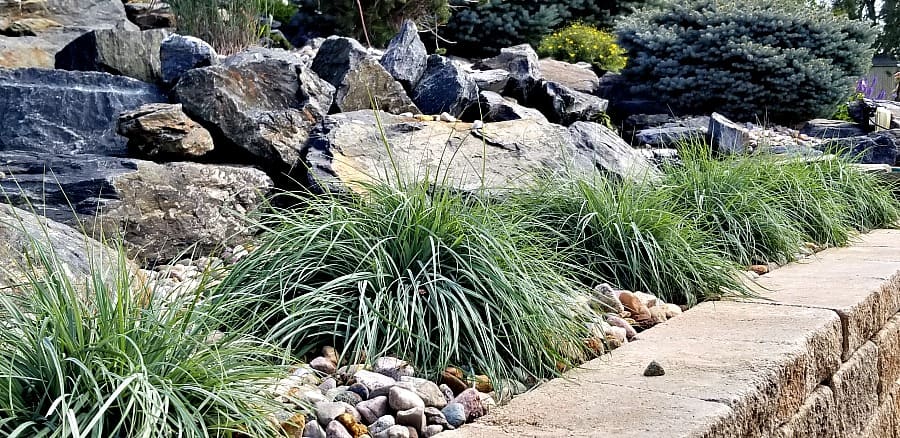Now that fall is here and plants are on sale across the nursery, remember Grimm’s Pink Flag Sale, we can talk about how to put in borders along your garden beds. Over the years, I have experimented with many different plants for borders, from groundcovers to squatty perennials to annuals. I like to use the following 4 perennials for a variety of conditions along the borders of both my gardens and my maintenance customers’ gardens.
Allium ‘Millenium’ Ornamental Onion
This low-growing, summer-blooming, perennial onion is a lover of full sun and heat. I like to use it for sunny garden borders in mulched garden beds. I can usually buy one or two full plants from the nursery, then divide in either spring or fall and get multiple plants for my garden borders. While there are several new cultivars available in the small ornamental onion family, I prefer ‘Millenium’ over the others. ‘Summer Beauty’ is nice, but its color is not noticeably different from ‘Millenium’, and ‘Mongolian Gem’ tends to be floppy. ‘Millenium’ Allium grows 12 inches tall and wide and blooms on short stalks in July and August with some rebloom in September. Pollinators love the blooms on this plant!

Blue Wood Phlox Phlox divaricata
There are some new cultivars starting to come out for this shade loving perennial, but they are in flower color only. I have some forage white-blooming wood phlox that may be available in the future, growing in my various shade border gardens. For part to full shade, and even sun with late afternoon shade, nothing beats wood phlox along the border. It stays a lovely dark green all summer long, and is one of the earliest risers and bloomers in spring. The dark green foliage is topped with delicate, blue-purple flowers in April and May. Plants grow 1 to 2 feet wide, and 6 inches tall.

Sedge ‘Blue Zinger
Sedges are fast becoming a popular addition to many gardens, with their many species adaptable to nearly every spot in the garden. ‘Blue Zinger’ is a cultivar with a variety of uses, in both sun and shade locations. This spreading sedge will fill gaps between plants, and grows equally well in mulch or rock beds. Along the border, it fills cracks and softens edges of fieldstones, looks amazing in a rock bed by a wall, and has soft, feathery blooms that add to its fine texture. ‘Blue Zinger’ grows 1 to 3 feet wide and 6 inches tall.

Sedum ‘Angelina’
Sedums have long been a part of the landscape, from the showy upright blooms of tall sedums to the lowscaping mounds of red-leaved and variegated forms of groundcover sedums. Sedum ‘Angelina’ is a low growing, chartreuse colored sedum that fills in quickly and nicely along borders. I have used it several times in full sun locations along rock gardens and sunny cottage gardens. Its foliage turns a brilliant orange color in autumn. It grows 6 inches tall and spreads variably.

Now is the time to plant and add new things to the garden, so come get your border plants now and they will be a great addition to the garden come next year.
Happy planting!


